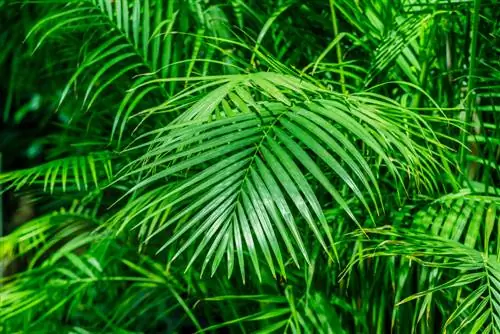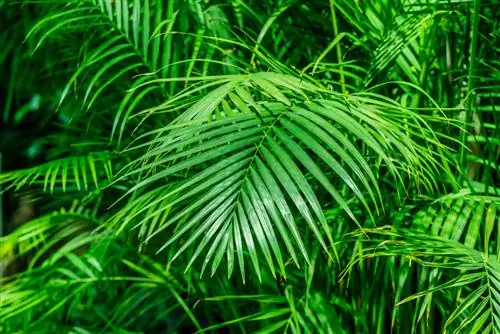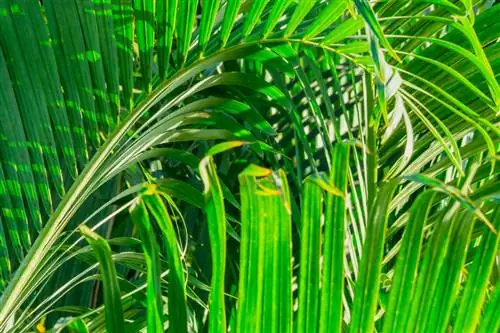- Author admin [email protected].
- Public 2024-01-05 20:48.
- Last modified 2025-06-01 06:02.
The golden fruit palm is one of the most popular larger indoor palms - after all, with its beautiful fronds it brings an atmosphere into the room that can evoke wanderlust. However, its cultivation requires a not quite so holiday-like laid back attitude.

How to care for a golden fruit palm?
The golden fruit palm (Dypsis lutescens) is a multi-stemmed indoor palm from eastern Madagascar. It prefers bright, indirect sunlight, constant, warm temperatures around 20°C and high humidity. When grown indoors, it reaches a height of around 3 meters. Regular watering, fertilizing and occasional repotting are required for their care.
Origin
The golden fruit palm is a so-called endemic - meaning it comes from a very specific region and is not common anywhere else. The endemic home region of the golden fruit palm is the eastern part of Madagascar. There it has chosen very specific areas of the local rainforest to grow and is considered an endangered species because of this sparse distribution. The golden fruit palm was imported from Madagascar to Germany as early as 1820.
To remember:
- Gold fruit palm only comes from very special areas of eastern Madagascar
- Original habitat tropical-humid
- Endangered Species
Growth
The golden fruit palm or areca palm, botanically Dypsis lutescens, grows as a tree with several tubular trunks that are close together. The individual trunks are quite thin and green at 5 to 7 centimeters, and depending on the light intensity they also turn yellow. The palm fronds form a wide, umbrella-like crown with their expansive blades and overhanging habit. In its natural habitat, the Areca can grow up to 10 meters high, but in the local indoor culture it usually ends at around 3 meters. Their growth rate is quite slow.
Growth characteristics at a glance:
- Multi-stemmed palm
- Trunks green or yellow depending on the light
- Sprawling, umbrella-like fronds
- In the wild up to 10 m high, in indoor cultivation around 3 m
- Slow growth rate
leaves
In the name of the golden fruit palm, its fruit is honored. In terms of their decorative value, the main focus in the local indoor culture is on their leaf fronds. These are not only particularly beautiful to look at, they are usually the only spectacular things the palm tree can offer. It almost never produces flowers in the room. The fresh green leaves have a typical palm-like pinnate structure with narrow, lanceolate individual leaves that are almost 2 to 2.5 centimeters long and form an attractive, V-shaped blade.
They sit on the approximately 60 cm long petioles in an elastic, swinging manner and therefore look particularly attractive when the palm tree is outside in summer.
Leaf properties at a glance:
- large, pinnate leaf blade with narrow, lanceolate individual leaves
- fresh green color
- long petioles, springy movement
Flowers
As already mentioned, the golden fruit palm almost never blooms when kept indoors. The necessary location conditions simply cannot be adequately met here. When a golden fruit palm produces flowers, they emerge below the crown as a large, spreading, multi-branched panicle with small, light yellow individual flowers.
Fruit
The appearance of the golden fruit palm fruits is based on their name - in fact, they appear in a golden, orange-yellow color. However, sometimes they can also take on a deep red or black color. They are egg-shaped false fruits, 2.5 centimeters long and with a fibrous, leathery texture.
Fruits in keywords:
- Gold to orange-yellow, deep red or black color
- Ogg-shaped, about 2.5 cm long mock fruits
Location
The golden fruit palm, like so many other rainforest plants, likes it very bright but not sunny. In its native habitat it is towered over by much taller plants, so it is not used to intense sunlight. So place it at home in a place where it gets a lot of light all day long, but is shaded by other large plants or a thin shade sail.
When it comes to temperature, the Areca prefers a warm 20°C - best all year round. The best place for it to stand permanently is in a heated winter garden. In the summer, a temporary freshening up on the terrace is also good for her. In winter it can be a little, but not significantly, cooler. However, your ambient temperature should not fall below 15°C.
The humidity should be as high as possible given its tropical homeland.
Location requirements at a glance:
- Gold fruit palm wants to be bright but protected from direct sunlight
- Temperature around 20°C all year round
- Can also be taken out in summer
- High humidity
Earth
The golden fruit palm needs a fresh and relatively nutrient-rich substrate. A mixture of commercially available potting soil with a fair amount of compost works well. The pH value should be in the slightly acidic range.
Alternatively, you can also grow the golden fruit palm hydroponically in a soilless substrate made of expanded clay over a water-nutrient solution. This also makes watering practice easier for you if you want to be finely dosed.
Pouring
The rule of thumb when it comes to water requirements for the golden fruit palm: moist, but not waterlogged. So casting requires a bit of sensitivity. You have to supply the palm tree with water regularly, especially in summer, and make sure that the ball of earth never dries out. The Areca is not allowed to stand in water either. Excess water in the saucer should be dumped out, at least the palm tree should not have wet feet for too long. Use water at room temperature if possible.
To remember:
- Areca needs a lot of water - but it has to be dosed carefully
- Avoid waterlogging - tip out any water that has been standing on the coaster for too long
Fertilize
During the main vegetation phase from spring to autumn, you can fertilize your golden fruit palm every one to two weeks with a simple universal liquid fertilizer (€13.00 on Amazon). Special palm fertilizers are even more suitable. In winter, increase the fertilization interval to at least 3 weeks.
When potting, provide the palm with good, ripe compost for a lasting supply of nutrients. You can also use fertilizer sticks for long-term fertilization.
Cutting
Elaborate pruning is not necessary for the golden fruit palm. It naturally grows beautifully compact at the base and does not spread out with its palm fronds. Due to its wide, swinging habit, the palm tree nevertheless naturally requires a lot of space. You can therefore remove outer fronds if necessary. Otherwise, only old, dried leaves need to be cut off. To do this, place the scissors directly at the base of the trunk.
If you are bothered by brownish leaf tips, you can also trim them. However, be careful not to penetrate the he althy leaf tissue.
Repotting
Since the golden fruit palm does not grow particularly quickly, repotting is not necessary very often. As a rule, an interval of around 2 to 3 years is sufficient. However, young specimens may need a new pot every year. But only repot if the palm tree's feet are really too tight. Because their roots are quite sensitive and should be left alone as much as possible. The ideal repotting time is spring.
To remember:
- Repot adult golden fruit palms about every 2-3 years
- Young specimens every year
- Repotting time: Spring
Propagate
offshoot
The easiest way to propagate a golden fruit palm is to use ground shoots. The golden fruit palm develops this when it has reached a certain age. You just need to separate them from the mother plant and place them in their own pot with humus-rich soil. But make sure that the sprout has reached a minimum length of around 30 centimeters and has formed he althy roots.
Place the pot with the young plant in a bright and warm place, protected from direct sunlight. It can be helpful for growth to cover the young daughter plant with a film with air holes to ensure an even, warm, humid climate.
Sowing seeds
Another variant is sowing seeds. It can be done all year round, but spring is best. However, much more patience is of course required here - both when growing and when waiting for a beautiful, fully grown palm tree. Keep in mind that the golden fruit palm has slow growth and therefore takes a few years to grow into an attractive specimen.
Place the seeds in bowls with potting soil and keep them evenly moist, if possible under a foil bag until they germinate. Golden fruit palm seeds take a relatively long time to sprout, around 4 to 5 weeks.
Diseases
Special diseases are not a big issue with the golden fruit palm. If it shows damage to the leaves, it is usually a sign of incorrect watering practices or incorrect location. More on that below.
As a secondary consequence of pest infestation, sooty mold can form due to injuries in the leaves. You can first combat this fungus by removing the diseased parts of the plant and, if necessary, using a fungicide.
Pests
As with many tropical plants that require high air humidity, the golden fruit palm can be infested with drought-loving pests in heated indoor cultivation. The typical candidates are spider mites, scale insects and mealybugs.
Spider mites
These small parasites are reddish, yellowish or solid in color and are best recognized by the fine webs with which they cover their host plant. They suck the plant sap from the leaves and usually stay on their undersides, where the larvae are laid.
The best way to remove spider mites is to first remove them mechanically by thoroughly rinsing the palm with a powerful water disperser. Then wrap the plant in foil and close it at the lower base of the trunk. After a week the pests should have died down underneath.
Scale insects
Scale insects are reddish to brownish in color and, when tapping the host plant, secrete sticky honeydew, which reveals their population. Ants that like to eat honeydew can also be an indicator of scale insect infestation.
You should also first remove scale insects from the golden fruit palm mechanically with water. The best way to do this is to use a wet cloth and wipe the leaves thoroughly. You can also use a spray treatment made from garlic, nettle or tansy decoction. For stubborn infestations, oil-based preparations that suffocate the lice are suitable.
Mealybugs
You can easily recognize mealybugs by their namesake woolly, white coat, which they put on when they suck on their host plant. The lice live on the entire plant and also lay their eggs in the substrate.
If the golden fruit palm is infested with mealybugs, you should first separate it from other plants to prevent transmission. The best way to combat lice is to spray with a mixture of spirit, water and soap (mixing ratio 15 ml - 1 l - 15 ml). If the substrate with the roots is also affected, you must repot the plant and carefully but thoroughly clean out the roots.
Whitefly
Occasionally the golden fruit palm can also be attacked by whiteflies. These animals are not actually insects, but rather whitefly insects. They get their name from their fly-like appearance, which is characterized by large wings covered with white wax dust. They live primarily on the undersides of the leaves, where they also place their larvae, and suck the sap of the host plant. Like scale insects, they secrete sticky honeydew.
If you notice a whitefly infestation on your golden fruit palm, you should act as soon as possible because the parasites spread quickly. As a first aid, you can stick sticky yellow tablets into the substrate to which the pests stick. It is also recommended to use preparations based on neem tree oil, which are very gentle on plants.
Prevention
You can keep all of the above-mentioned pests away from your golden fruit palm by ensuring sufficient humidity. Treat her regularly to a fine mist shower from the water disperser. You should also regularly ventilate your winter garden or the greenhouse in which your golden fruit palm is located.
Yellow leaves
Yellow colored leaves on the golden fruit palm usually indicate an infestation by spider mites. But too much watering can also be the reason. Never leave the palm tree standing in water for too long. If the yellow discoloration is accompanied by a patchy structural change and the leaves increasingly fall off, this is an indication of a pest infestation.
Brown leaves
If the golden fruit palm leaves turn brown, this is usually a sign of excessive dryness. Either it hasn't been watered enough or the air in the room is too dry. Always ensure there is sufficient humidity. But it may also be that you have exposed your palm to too much sunlight and the leaves have simply burned. In this case, shade them and remove the brown leaves.
Poisonous
The Areca palm is not poisonous. So you don't necessarily need to wear gloves when cutting or repotting, nor do you need to keep children and pets away.
Food
You should not eat parts of the golden fruit palm plant. Although there is no risk of poisoning, the individual leaves of the palm fronds are quite pointed and sharp-edged. Curious small children or cats could injure their mucous membranes if they try to eat them.
Tip
The golden fruit palm has made it onto NASA's list of air-purifying plants. It is able to neutralize xylenes and toluene from the air to a greater extent. It can therefore have a long-term he alth-promoting effect in rooms where adhesives, paints and solvents are used and where there is an increased concentration of these substances, which are particularly harmful to the respiratory system.
Varieties
There are no special varieties of the golden fruit palm.






